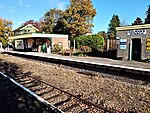Buxton Heath
Nature Conservation Review sitesSites of Special Scientific Interest in NorfolkSpecial Areas of Conservation in England

Buxton Heath is a 67.3-hectare (166-acre) biological Site of Special Scientific Interest north of Norwich in Norfolk. It is a Nature Conservation Review site, Grade 2, and part of the North Valley Fens Special Area of Conservation.This site has areas of dry acidic heath on glacial sands, but the main ecological interest lies in the mire along the valley of a small stream. There are a number of rare relict mosses, liverworts and fungi, and uncommon invertebrates include one species not previously recorded in Britain.The heath is managed by the Buxton Heath Wildlife Group.
Excerpt from the Wikipedia article Buxton Heath (License: CC BY-SA 3.0, Authors, Images).Buxton Heath
Cutthroat Lane, Breckland District
Geographical coordinates (GPS) Address Nearby Places Show on map
Geographical coordinates (GPS)
| Latitude | Longitude |
|---|---|
| N 52.666 ° | E 0.974 ° |
Address
Cutthroat Lane
NR19 1RG Breckland District
England, United Kingdom
Open on Google Maps








